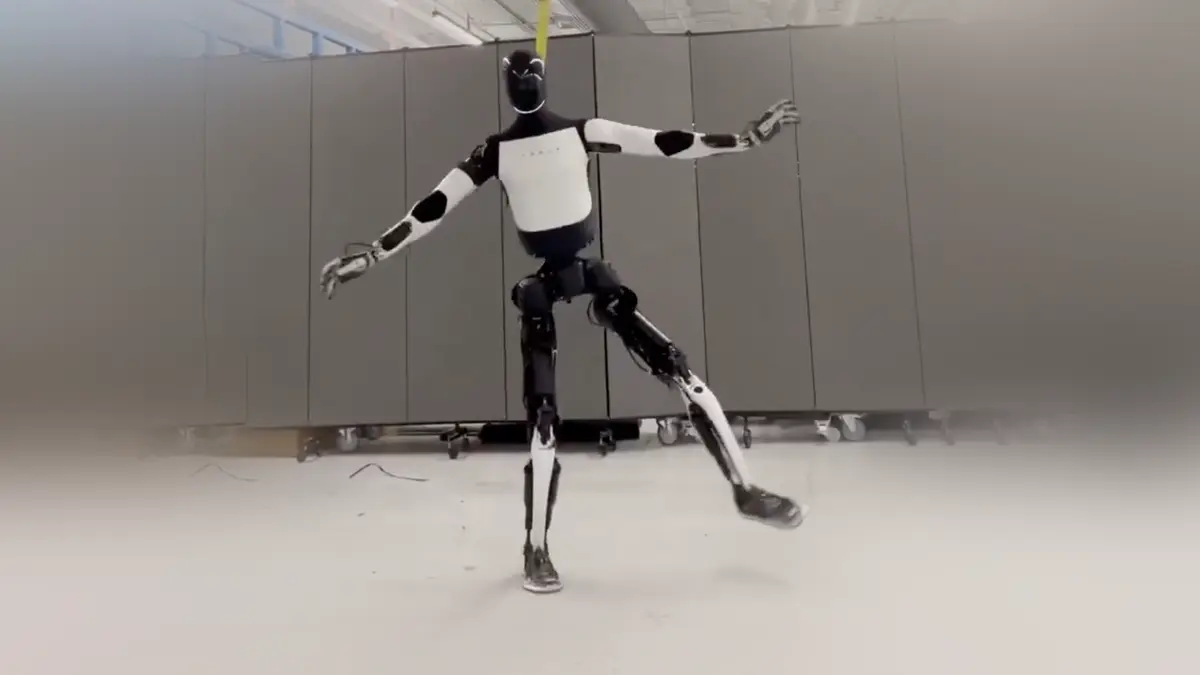- Published on
Optimus Shows Off New 'Real-Time' Dance Moves as Humanoid Agility Advances

Optimus Showcases New "Real-Time" Dance Moves as Humanoid Agility Advances
Tesla's Optimus humanoid robot has once again captured attention with a new video showcasing more fluid and rapid movements, described by CEO Elon Musk as operating in "real real-time." The demonstration highlights ongoing progress in the company's robotics division and reflects broader, swift advancements in the agility and capabilities of humanoid machines across the industry.
Simulation-Driven Progress at Tesla
The video, shared by Musk, depicts an Optimus unit performing a dance. In a follow-up, Musk emphasized the real-time nature of the robot's actions. Milan Kovac, from Tesla's Optimus engineering team, provided further context, stating, "The team has been working very hard in the background. Entirely trained in simulation with RL [Reinforcement Learning]. Many optimizations and fixes have been put in place in our sim-to-real training code." Kovac also noted that a visible cable in the video was a safety measure for falls, clarifying it was "not actually holding the bot," and described the demonstration as an "early result which will get more stable very quickly."
More coming shortly! The team has been working very hard in the background. Entirely trained in simulation with RL. Many optimizations and fixes have been put in place in our sim-to-real training code. The cable is there in case of a fall (not actually holding the bot) since
This latest update follows a previous demonstration on April 2nd, where Optimus was shown walking with a more natural gait, including straight knees and arm sway. That achievement, too, was attributed by Kovac to being "Entirely trained in simulation with RL." Musk's comment at the time, "Accurate actuators accelerate automation," hinted at the underlying hardware and software synergy Tesla is pursuing.
Competitive Landscape Heats Up
Tesla's advancements arrive amidst a flurry of activity from other players in the humanoid robotics space. Earlier this year, Chinese competitors Unitree Robotics and EngineAI also displayed robots with impressive dynamic capabilities.
EngineAI garnered attention with a video of its PM01 robot, dubbed an "Axe Gang Trainee," performing elaborate moves inspired by the movie Kung Fu Hustle. The company highlighted features like "0.01s precision joints," "Force-control algorithms," and "Up to 24-DOF full-body sync" as key to the robot's performance, emphasizing that the robot trained with professional human dancers.
Unitree Robotics has also released several videos of its G1 humanoid robot dancing, claiming that with an upgraded algorithm, the G1 "can learn any dance." Some demonstrations showed the G1 maintaining balance even when poked with a stick, underscoring advancements in stability. Unitree noted that such features were recently developed and rollout to customers might vary.
Academic Breakthroughs in Balance
Concurrent with these commercial developments, academic research continues to push the boundaries of robotic control. A notable recent example is the HuB (Humanoid Balance) project, a collaboration involving Tsinghua University, Shanghai Qi Zhi Institute, and other institutions, including UC Berkeley and UC San Diego. Using the Unitree G1 as a platform, the research team demonstrated remarkable balancing feats.
Their paper details a framework designed to overcome key challenges in applying reinforcement learning to balance-intensive tasks, such as instability from reference motion errors, difficulties due to morphological differences between humans and robots, and the sim-to-real gap. The HuB framework integrates "reference motion refinement, balance-aware policy learning, and sim-to-real robustness training." The team successfully enabled the Unitree G1 to perform challenging quasi-static poses like "Swallow Balance" and "Bruce Lee's Kick," maintaining stability even under significant physical disturbances.
Following up on @Stanford's "Twist" (human-like teleoperation), now see the @UnitreeRobotics G1 master extreme balance with the "HuB" system from @TongZha22057330 & team (Tsinghua et al.). Incredible stability in poses like "Bruce Lee's Kick". More great research on this platform
Stanford's "Twist" system showcases remarkable whole-body teleoperation on a Unitree G1. The robot's ability to perform complex, human-like tasks underscores @UnitreeRobotics impact on accessible humanoid research. Great work by @ZeYanjie and team!
The Path Forward
The recent demonstrations from Tesla, its competitors, and academic labs underscore a period of rapid evolution in humanoid robotics. The recurring themes of training in simulation, reinforcement learning, and sophisticated sim-to-real transfer techniques appear central to these advancements. While Optimus's progress is significant, the broader field is dynamic, with multiple entities contributing to the development of more agile and capable humanoid robots. As these machines become more adept, questions about their practical applications and integration into various environments will become increasingly pertinent.
Share this article
Stay Ahead in Humanoid Robotics
Get the latest developments, breakthroughs, and insights in humanoid robotics — delivered straight to your inbox.